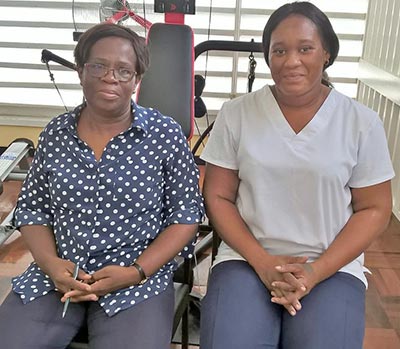Leading wounded athletes along the road to recovery
MANY ‘moons’ ago, under Guyana’s late President Forbes Burnham, a sports clinic which catered specifically to the needs of injured athletes was built in the compound of the Castellani House. Due to a great exodus of physiotherapists there, however, the facility eventually closed.

A little over two years now, however, it was re-opened to offer the same services and now sees approximately 40 patients a week on its two opening days, Tuesdays and Thursdays.
Physiotherapist within the Ministry of Public Health and Coordinator of the National Sports Clinic, Beverly Nelson, told the Pepperpot Magazine that anyone can benefit from the facility, free of charge, once they suffered a sports-related injury.
From the very popular athletes to school children to the group of young men playing football on the street corner – everyone is welcome at the facility. “Once someone has an injury playing a sport, they can come into us. We’re at that level where we can be first contact for those persons,” Nelson explained.
Fortunately, a doctor, Victor Allen, is present at the facility every Tuesday and is also on hand on Thursdays in case of emergencies. Along with Nelson, another physiotherapist, Vanessa Wickham, also works at the facility together with a rehabilitation assistant.
While the clinic really caters to the needs of sports-related injuries, Nelson said they make considerations to accommodate anyone with an injury.
Explaining why a facility of this sort is needed, she said: “Sportsmen with an injury are not sick people and for them to leave to go to the hospital with their injury and be among persons who have a cold, flu and all that; you find that the sportsman would not want to do that.

“When they have to go to the hospital and wait with other people in long lines, they don’t do that. So they keep going along and their injury gets worse until when they do decide to seek medical attention, they may need surgery and that sort of thing. So this facility has the capacity to help the athlete very early on.”
Even school children who play sports visit the clinic before school and during their lunch break. “And they don’t have to wait because they have to get back to school. So the facility is needed so that sportsmen and women don’t have to join a long line or [visit] a hospital to seek medical attention.”
Furthermore, Nelson said that in visiting the hospital, the most that would be ordered are tablets and other medicine. “Here, we work on the muscle, ligament; the weak muscles. So we work on the actual problem and not just give medication.”
With the clinic closed for a number of years due to a shortage of staff, Nelson said they realised the importance of re-opening the clinic for the country’s sportsmen and women, elite or not.

In the near future, they are hoping to have a nutritionist at the facility so that the needs of the athletes can be catered for holistically, she said.
Some of the popular and well-loved athletes who have passed through the facility include Veerasammy Permaul, Leon Johnson, Narayan Ramdhani and Shivnarine Chanderpaul, among many others.
Dr. Allen told this publication that his job includes providing a diagnosis and helping the athletes to get back on the field as soon as possible. “I diagnose, do all further referrals and treatment plans with the physiotherapist. My job is basically to diagnose and to see if they are getting better. If I think that they are not progressing well, I intervene and say maybe we need to consult with internal medicine, or with surgery to straighten out any problem that I think is there, and then we can continue with more physiotherapy,” he explained.
Explaining what the facility can do for a patient, he said: “We put you back to normal functioning. For instance, if a cricketer comes in with injuries to his finger, he may not be able to function for months on a normal basis. But once he’s here early, within a period of about eight sessions, we can get him back on his feet. We also advise the coaches how to go about with the training and what to avoid. So the athletes are back in the field at a faster pace.”




.jpg)










